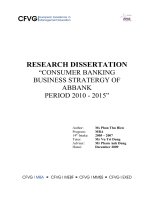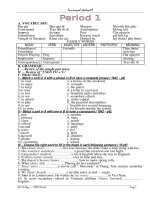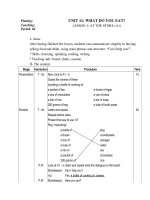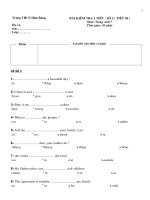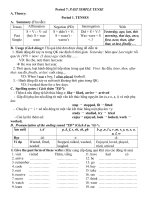Victorian period
Bạn đang xem bản rút gọn của tài liệu. Xem và tải ngay bản đầy đủ của tài liệu tại đây (563.39 KB, 17 trang )
Victorian Literature
Victorian era
Refers to the time during the reign of Queen Victoria 1837-1901
Victorian era
The Victorian era is characterized by English imperialism. England
was rapidly expanding. Queen Victoria was named Empress of India
The Victorian era is also thought to be a time of rigid morals and
repressed sexuality. Reading became a new past time because some
theatre was regarded as “immoral”
Homosexual behavior was regarded as a criminal offense and several
writers like Oscar Wilde were sentenced to hard labor for engaging in
“homosexual activities”
19th Century novel
The novel became the leading form of literature in the Victorian age,
and the 19th century is often regarded as the high point of British
literature
Famous Victorian writers include: the Bronte sisters, Sir Arthur Conan
Doyle, Charles Dickens, William Makepeace Thackeray, Oscar Wilde
and Lewis Carroll
Charles Dickens
Dickens wrote his first novel at the age of 25, The Pickwick Papers,
which became very successful
He wanted to write entertaining pieces but his real goal was to offer
commentary on the social challenges of the era, including the plight of
the poor and the oppressed
Like many writers his work started as more lighthearted, but near the
end of the century it took a turn toward darker themes
Victorian novel
Victorian novels tend to focus on the difficult lives of characters, with
the idealized notion that hard work, perseverance, love and luck win
out in the end
It follows the belief that virtue is rewarded and wrongdoers are
punished
There is usually a central moral lesson
Children’s Literature
The Victorians are credited with starting literature for children
Because several laws were enacted which ended child labor, and
began required education, more children were able to read
Several authors wrote for children, and had an adult following as well,
including Lewis Carrol (Alice in Wonderland)
Gothic Literature
Gothic literature is an example of “fantastic fiction”
Often the characters were larger than life, like Sherlock Holmes, and
had exotic enemies to defeat
Other Gothic characters include Dracula and The Invisible Man
Combines romance and horror in an attempt to thrill and terrify and the
reader
Gothic Literature
Features include: foreign monsters, ghosts, curses, hidden rooms and
witch-craft
Usually are set in castles, monasteries or cemeteries
Wuthering Heights
Written by Emily Bronte, it is a classic example of Gothic Romanticism
It features violence, passion, the supernatural and heightened emotion
It was not immediately appreciated by Victorian readers, as women
were “supposed” to write romances
The Gothic Novel
Emphasis on the power of imagination and the supernatural
Presents a taste for the mysterious and macabre
Nature parallels action and experience
Horror, death, and gruesome or supernatural events dominate
Character motivations are often dark
Frankenstein
Story opens on the ship
of an English explorer,
Robert Walton, in the
Arctic Ocean
Walton serves as a
framing device for the
real action of the story:
the creation of a
monster by Dr. Victor
Frankenstein
Walton rescues a drowning Dr.
Frankenstein who tells him the story
In the flashback, Victor tells of his
obsession with creating a human
being, but is horrified by the
monstrous result
Victor abandons his monster and
the monster sets out on his own.
Rejected by humanity, the monster
becomes enraged and kills Victor’s
brother. The monster then demands
that Victor make him a wife. Victor
obeys, but then kills the female
monster out of fear.
The monster kills Victor’s friend and
wife in retaliation.
The End…
After Walton rescues Victor
and hears his tale, the
scientist dies.
The monster comes to the
ship to grieve for his fallen
creator
The book ends when the
monster goes to the North
Pole to destroy himself.
Walton returns to England,
and the reader is left feeling
like the monster could be out
there somewhere…
Gothic Elements in Jane Eyre
As a girl, Jane’s punishment is
to be locked in a red room
where a relative had previously
died. She later sees the ghost.
Some characters hold
frightening and dark secrets,
contributing to the atmosphere
of mystery.
Two terrible and destructive fires
occur.
We eventually discover the fact
that a menacing and insane
woman has been in the home of
Jane’s employer (and love
interest) for most of the plot.
One character, Rochester,
receives disfiguring injuries.
Victorian Poetry
Seen as a bridge between the earlier “Romantics” and the modernist
poets of the 20th Century
Several important poets include Elizabeth Barrett Browning and her
husband, Robert Browning, Alfred Lord Tennyson, Matthew Arnold and
Gerard Manley Hopkins
Features a resurgence of Medieval interests blended with
contemporary concerns (Idylls of the King)
Science in the Victorian era
Important time for the development of science, tried to describe and
classify the natural world
Charles Darwin On the Origin of the Species about the theory of
evolution. Although it took a long time to be accepted, it dramatically
affected society and thought.
